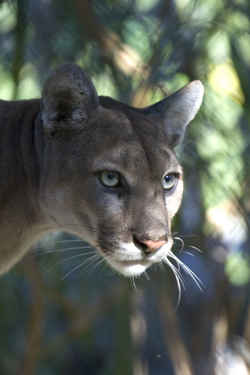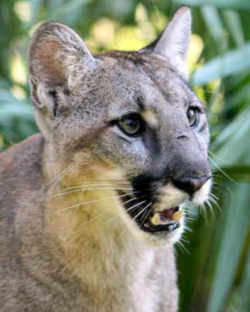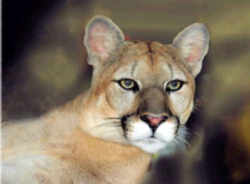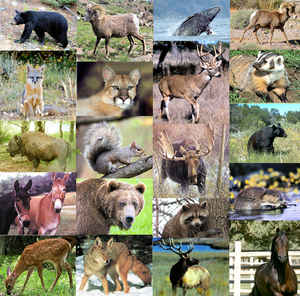
Florida Symbols
Florida State Animal
Florida Panther

(Felis concolor coryi)
Adopted in 1982
The Florida Panther, (Felis concolor coryi,) is a large (six feet or longer), long-tailed, pale brown cat. It was adopted as Florida's state animal in 1982 which was chosen in 1982 by a vote of students throughout the state.
Florida panthers once prowled and flourished in woodlands and swamps throughout the Southeast. When European settlers arrived in the 1600s, the clear-cutting, building and other human activities that destroy, degrade and fragment habitat began, and the fear and misconceptions that led to panther persecution took root. Today, the panther is recognized as Florida's official state animal but it is one the most endangered mammals on Earth.
Florida State Animal: Florida Panther

The Florida panther is an endangered subspecies of cougar (Puma concolor) that lives in forests and swamps of southern Florida in the United States. Its current taxonomic status (Puma concolor coryi or Puma concolor couguar) is unresolved, but recent genetic research alone does not alter the legal conservation status. This species is also known as the cougar, mountain lion, puma, and catamount; but in the southeastern United States and particularly Florida, it is exclusively known as the panther. Florida Panthers are usually found in pinelands, hardwood hammocks, and mix swamp forests.
Its habitat is usually the same as that of the white-tailed deer, the mainstay of its diet. Much folklore surrounds these seldom-seen cats, sometimes
called "catamounts" or "painters," and they have been persecuted out of fear and misunderstanding of the role these large predators play in the natural
ecosystem. Human population growth, however, has been the primary threat to the panther's range and continues to diminish the quality of existing habitats.
The Panther has been protected from legal hunting in Florida since 1958. It has been on the federal endangered species list since 1967 and on the state's
endangered list since 1973. The future of this large animal depends entirely on the management decisions that are made today on its behalf. The Florida
Game and Fresh Water Fish Commission is responsible for management and preservation of this endangered State Animal, but only with your support will
the Florida Panther remain a part of our unique wildlife community.
The Florida panther is a large, long-tailed cat with a great deal of color variation: pale brown or rusty upper parts, dull white or buffy under parts; tail tip, back of ears, and sides of nose are dark brown or blackish. Mature male panthers examined in the wild in Florida since 1978 have weighed from 1O2 to 154 pounds (Roelke 1990, Roelke and Glass 1992) and measured nearly 7 feet from nose to tip of tail. Females were considerably smaller, with a weight range of 50 to 1O8 pounds (Roelke 1990) and measuring about 6 feet (US Fish and Wildlife Service 1987).
HABITAT

In general, panther population centers appear to indicate a preference toward large remote tracts with adequate prey, cover, and reduced levels of disturbance. A telemetry study on the Florida panther was initiated in south Florida by the Florida Game and Fresh Water Fish Commission (Commission) in 1981. This initial study has since been expanded by the Commission, and the National Park Service initiated additional studies in 1986. One of the goals of these telemetry projects is to learn more about panther habitat. As of June 1993, data had been gathered from 54 radio-instrumented panthers.
Data from panthers monitored by the Commission in southwest Florida since 1985 indicate that, overall, habitat use is highly diverse and varies from north to south. Diversity of habitats used by panthers is greater in northern parts of the study area and dominated by uplands (hardwood hammocks, low pinelands, and palm forests). Lower diversity and predominately wetland habitat use are characteristic of southern areas (mixed swamp and cypress swamp). Appropriate cover is an important component of habitats used, especially during hunting, denning, and day-bedding. Saw palmetto was the dominant cover in 72 percent of observed day bedding sites.
Annual home-range sizes of 26 instrumented panthers monitored in southwest Florida varied from 20 to 457 mi2. Home ranges averaged 200 mi2 for resident adult males, 75 mi2 for adult females, 241 mi2 for transient males, and 69 mi2 for sub-adult females (Maehr et al. 1991).
Florida Law
The law designating the Florida panther as the official Florida state animal is found in The Florida Statutes, Title 4, Chapter 15, Section 15.0353.
TITLE IV EXECUTIVE BRANCH
CHAPTER 15 SECRETARY OF STATE
SECTION 15.0353
15.0353 Official state animal. --The Florida panther is hereby designated and declared as the official Florida state animal.
History.--s. 1, ch. 82-61.
Taxonomic Hierarchy: Florida Panther
Kingdom: Animalia
Phylum: Chordata
Class: Mammalia
Order: Carnivora
Family: Felidae
Genus: Puma
Species: P. concolor
Subspecies: P. c. coryi - Bangs, 1899







